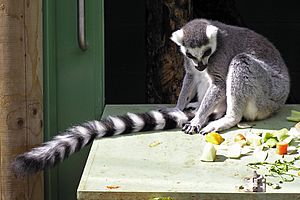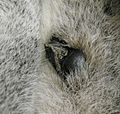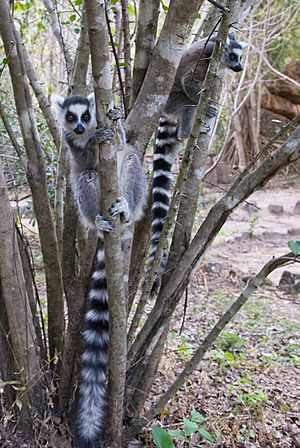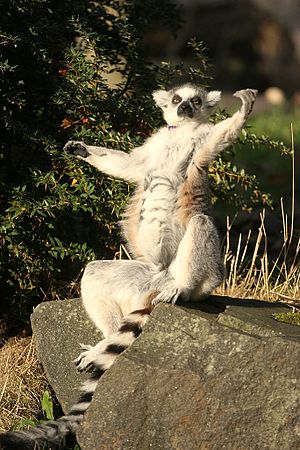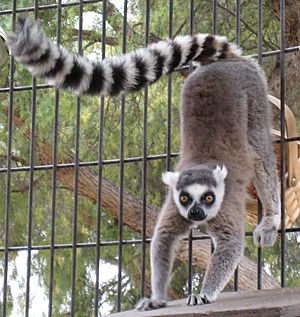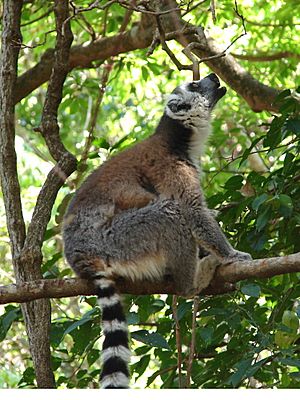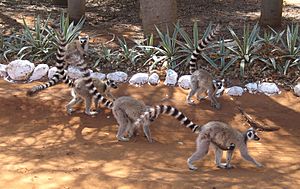Ring-tailed lemur facts for kids
Quick facts for kids Ring-tailed lemur |
|
|---|---|
 |
|
| Conservation status | |
| Scientific classification | |
 |
|
| Native range of Lemur catta |
The ring-tailed lemur is a type of primate that belongs to the group of lemurs. It lives in the dry areas of southwest Madagascar.
This lemur usually weighs between 2 and 3.5 kilograms (4.4 to 7.7 pounds). It can live for up to 20 years. It is a medium-sized lemur, easy to spot because of its striped tail. Its behavior is a bit special for lemurs: it is active during the day and spends a lot of time on the ground. Ring-tailed lemurs live in groups of 12 to 15 animals. A female lemur always leads each group. These lemurs eat both meat and plants, but they mostly eat fruit. They are found only in Madagascar. The biggest dangers to ring-tailed lemurs are losing their homes and hunting.
Contents
About the Ring-tailed Lemur's Body
An adult Ring-tailed Lemur can grow to be about 39 to 46 centimeters (15 to 18 inches) long. It weighs between 2.3 and 3.5 kilograms (5.1 to 7.7 pounds). This lemur has a thin body and a narrow face, which looks a bit like a fox's snout. Like all lemurs, its back legs are longer than its front legs. Female lemurs have two pairs of mammary glands, but only one pair works.
Both male and female lemurs have special scent glands without fur. These glands help them communicate. Males also have a hard spur near their wrist glands.
The Ring-tailed Lemur's most famous feature is its long, bushy tail. It has 13 to 15 black and white stripes that go all the way around. The tip of the tail is always black. The tail is longer than its body, reaching up to 64 centimeters (25 inches) in length. This tail cannot grab things. It is only used for balance, sending messages, and keeping the group together.
The lemur's fur is thick. Its chest and throat are white or cream colored. Its back is gray to rosy-brown. The top of its head is dark gray, while its ears and cheeks are white. Its nose is black, and its eyes have black patches around them that look like diamonds.
The skin on its nose, private parts, and the palms of its hands and feet is black. The Ring-tailed Lemur has slender, padded fingers with flat, human-like nails. It cleans itself by licking and using its special lower teeth, called a toothcomb. It also has a special "grooming claw" on the second toe of each back foot. This claw helps it comb through fur that its mouth cannot reach.
The eyes of this lemur can be bright yellow or orange. Unlike most primates active during the day, the Ring-tailed Lemur has a special reflective layer behind its eye. This layer helps it see better in the dark.
- Ring-tailed Lemur anatomy
-
Front, lower dentition includes a toothcomb
Life in the Wild

The Ring-tailed Lemur is active during the day and spends a lot of time on the ground. It is the lemur species that spends the most time on the ground, up to 33% of its day. However, it also spends a lot of time in trees. It spends 23% of its time in the middle parts of trees and 25% in the top parts.
The size of lemur groups, their home areas, and how many lemurs live in an area can change. This depends on where they live and how much food is available. Groups usually have 6 to 25 lemurs, but some groups have been seen with over 30. An average group has 13 to 15 lemurs. Their home areas can be from 6 to 35 hectares (15 to 86 acres) in size. Lemur groups will protect their territory, but their areas often overlap. When different groups meet, they can be hostile. A group usually stays in one part of its home area for three or four days before moving. When they move, they travel about 1 kilometer (0.6 miles) on average.
The Ring-tailed Lemur has both natural predators and predators brought in by humans. Natural predators include the Fossa, the Madagascar Harrier-hawk, the Madagascar Buzzard, and the Madagascar Ground Boa. Predators brought in by humans include the Small Indian Civet, domestic cats, and domestic dogs.
Where Ring-tailed Lemurs Live
The Ring-tailed Lemur lives only in southern and southwestern Madagascar. It can be found in higher areas than other lemurs. It lives in forests that lose their leaves, dry scrubland, humid mountain forests, and forests along riverbanks. They really like forests along riverbanks, but many of these forests have been cut down in Madagascar for farm animals. Depending on the location, temperatures where they live can range from -7°C (19°F) to 48°C (118°F).
This species is found as far east as Tôlanaro and north to Belo sur Tsiribihina. They live along the west coast and inland towards the mountains of Andringitra. You can see them in places like the Berenty Reserve, Andohahela National Park, Isalo National Park, and Zombitse-Vohibasia National Park.
Behavior and Social Life
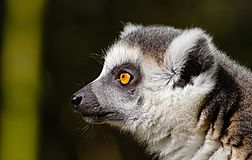
What They Eat
The Ring-tailed Lemur is an omnivore, meaning it eats both plants and animals. It mainly eats fruits and leaves, especially from the tamarind tree. The tamarind tree is known locally as kily. When tamarind is available, it can make up to 50% of their diet, especially in the dry, winter season. The Ring-tailed Lemur eats from about three dozen different plant types. Its diet also includes flowers, herbs, tree bark, and sap. They have been seen eating rotten wood, earth, spider webs, insect cocoons, arthropods (like spiders, caterpillars, and grasshoppers), and small vertebrates (like birds and chameleons). During the dry season, they become more flexible in what they eat.
How They Live in Groups
Lemur groups have both males and females, with a female leading the main group. Like most lemurs, females are always in charge of males, even when it comes to eating first. Females show their dominance by lunging, chasing, hitting, grabbing, and biting. Young females do not get their mother's rank. Young males leave their birth group when they are between three and five years old. Both sexes have their own ranking systems. Females have a clear ranking, while male rank is linked to their age. Each group has one to three main, high-ranking adult males. These males spend more time with females and lead the group with high-ranking females. Males who have recently joined the group, older males, or young adult males who have not yet left their birth group are often lower in rank. They tend to stay on the edge of the group and are less involved in group activities.
For males, their social structure can change with the seasons. Between December and May, some males move between groups. Established males move groups about every 3.5 years, but young males might move every 1.4 years. Groups split up when they get too big and there is not enough food.
In the mornings, Ring-tailed Lemurs sunbathe to warm up. They face the sun, sitting in a position often called "sun-worshipping." They sit with their legs stretched out, not crossed, and often lean on nearby branches. Sunning is often a group activity, especially on cold mornings. At night, groups split into smaller sleeping parties. They huddle close together to stay warm. A group of huddled Ring-tailed Lemurs is called a lemur ball.
Even though they walk on four legs, Ring-tailed Lemurs can stand up and balance on their back legs. They usually do this to show aggression. When they feel threatened, they might jump in the air and strike with their short nails and sharp upper canine teeth. This is called jump fighting. This is very rare except during the breeding season when there is a lot of tension and competition for mates. Other aggressive behaviors include a "threat-stare" to scare others or start a fight, and a submissive gesture called "pulled-back lips."
Fights over territory with other lemur groups happen sometimes. It is the job of the dominant female to protect her group's home area. These fights include staring, lunging, and sometimes physical attacks. They end with group members going back to the center of their home area.
Smell Communication
Smell is very important for lemurs like the Ring-tailed Lemur to communicate. Males and females use their special scent glands to mark both vertical and horizontal surfaces where their home areas overlap. The Ring-tailed Lemur will do a handstand to mark vertical surfaces. It grasps the highest point with its feet while putting its scent on it. How much they use scent marking depends on their age, sex, and social status. Male lemurs use their arm and shoulder glands to mark their territory and show who is in charge within the group. The thorny spur over the arm gland on each wrist is scraped against tree trunks to make marks with their scent. This is called spur-marking.
When males are aggressive, they do a social display called stink fighting. They put scent from their arm and shoulder glands onto their tails. Then they wave their scented tails at other male rivals. During mating season, males wave their scented tails at females. This usually makes the female hit or bite the male, and the male makes sounds showing he is submissive.
Sound Communication
The Ring-tailed Lemur is one of the most vocal primates. It has many different sounds it uses to communicate. These sounds help keep the group together when they are looking for food. They also warn group members if a predator is nearby. Calls can be simple or complex. A simple call is a purr, which means they are happy. A complex call is a series of clicks and yaps used when they are mobbing a predator.
The most common sounds you will hear are the moan (for low to moderate excitement, keeping the group together), the early-high wail (for moderate to high excitement, keeping the group together), and clicks (to get attention).
Reproduction and Life Cycle
Pregnancy lasts about 135 days. Births usually happen in September or sometimes October. In the wild, one baby is normal, but twins can happen. Ring-tailed Lemur babies weigh about 70 grams (2.5 ounces) at birth. They are carried on their mother's chest for the first 1 to 2 weeks, then on her back.
The young lemurs start eating solid food after two months. They are fully weaned (stop drinking milk) after five months. They become adults between 2.5 and 3 years old. Male lemurs do not help much with raising the babies. However, the whole group, no matter their age or sex, can be seen caring for the young. The Ring-tailed Lemur can live 16 to 19 years in the wild, and up to 27 years in zoos.
Conservation Status
The Ring-tailed Lemur was listed as endangered in 2014 by the IUCN. Since 1977, it has also been listed by CITES under Appendix I. This means it is illegal to trade wild-caught Ring-tailed Lemurs. Even though there are other lemur species that are more endangered, the Ring-tailed Lemur is considered a "flagship species" because it is so well-known. As of 2017, it is thought that only about 2,000 Ring-tailed Lemurs are left in the wild. This makes the threat of them disappearing much more serious than once thought.
Three main things threaten Ring-tailed Lemurs. The biggest threat is the destruction of their habitat. Today, it is believed that 90% of Madagascar's original forests have been lost. More people living in the southwest part of the island means a greater need for wood for cooking, charcoal, and building. Fires from clearing grasslands and "slash-and-burn" farming also destroy forests.
Another threat to the species is being hunted for food (bushmeat), for their fur clothing, or to be kept as pets. Finally, periods of drought, which are common in southern Madagascar, can harm populations that are already declining. For example, in 1991 and 1992, a severe drought caused many baby lemurs and females to die at the Beza Mahafaly Special Reserve. Two years later, the population had dropped by 31% and took almost four years to start getting better.
Outside of their shrinking habitat and other threats, the Ring-tailed Lemur reproduces easily and has done well in captivity. Because of this, and its popularity, it has become the most common lemur in zoos worldwide. In 2009, there were more than 2500 in captivity. It is also the most common of all captive primates.
Ring-tailed lemur populations can be helped during droughts. This is seen at the Berenty Private Reserve in southern Madagascar, where watering troughs and fruit trees have been added. However, some people do not like these actions because they stop natural changes in the population. The species is thought to have developed its ability to have many babies because of its tough environment.
Images for kids
See also
 In Spanish: Lémur de cola anillada para niños
In Spanish: Lémur de cola anillada para niños



